Tesco PLC: Logistics and Supply Chain Management Analysis
VerifiedAdded on 2020/05/04
|13
|2917
|98
Report
AI Summary
This report provides a comprehensive analysis of Tesco PLC's logistics and supply chain management, examining how these strategies enhance the company's competitiveness. It explores the relationship between e-business and e-commerce, highlighting the benefits Tesco gains from recent developments and innovations in these areas. The report delves into the best practices Tesco has implemented, such as centralization, continuous replenishment, and JIT logistics, and analyzes the benefits derived from these practices, including improved efficiency, reduced costs, and enhanced customer satisfaction. Furthermore, the report discusses the impact of e-commerce strategies, like the Clubcard, on Tesco's ability to gather customer data and build strong relationships. The analysis covers the company's supply chain structure, distribution processes, and network planning, emphasizing the importance of logistics in meeting customer demands and achieving financial success. The report concludes by summarizing the key findings and emphasizing the vital role of logistics and supply chain management in the success of a major retailer like Tesco.

Running head: LOGISTICS AND SUPPLY CHAIN MANAGEMENT
LOGISTICS AND SUPPLY CHAIN MANAGEMENT
Name of the Student
Name of the University
Authors Note
LOGISTICS AND SUPPLY CHAIN MANAGEMENT
Name of the Student
Name of the University
Authors Note
Paraphrase This Document
Need a fresh take? Get an instant paraphrase of this document with our AI Paraphraser

1LOGISTICS AND SUPPLY CHAIN MANAGEMENT
Table of contents
Introduction................................................................................................................................4
Logistics management of Tesco Plc enhance competitiveness..................................................4
Relationship between e-business and e-commerce....................................................................6
Tesco plc benefits from recent developments and innovations in e-business/e-commerce.......7
Best practices that Tesco Plc has implemented in logistics.......................................................9
Analysing benefits from implementation.................................................................................10
Conclusion................................................................................................................................11
References................................................................................................................................12
Table of contents
Introduction................................................................................................................................4
Logistics management of Tesco Plc enhance competitiveness..................................................4
Relationship between e-business and e-commerce....................................................................6
Tesco plc benefits from recent developments and innovations in e-business/e-commerce.......7
Best practices that Tesco Plc has implemented in logistics.......................................................9
Analysing benefits from implementation.................................................................................10
Conclusion................................................................................................................................11
References................................................................................................................................12
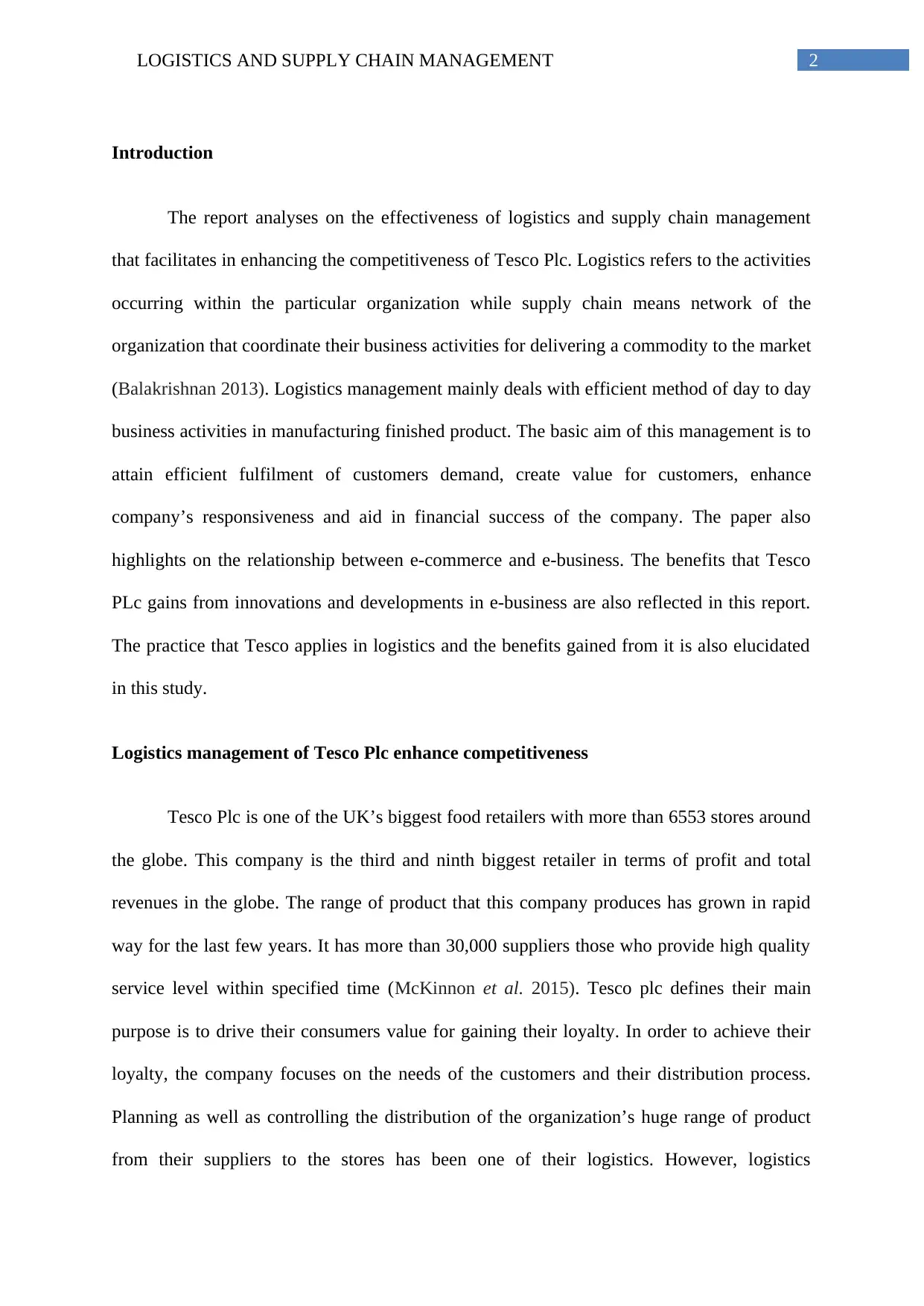
2LOGISTICS AND SUPPLY CHAIN MANAGEMENT
Introduction
The report analyses on the effectiveness of logistics and supply chain management
that facilitates in enhancing the competitiveness of Tesco Plc. Logistics refers to the activities
occurring within the particular organization while supply chain means network of the
organization that coordinate their business activities for delivering a commodity to the market
(Balakrishnan 2013). Logistics management mainly deals with efficient method of day to day
business activities in manufacturing finished product. The basic aim of this management is to
attain efficient fulfilment of customers demand, create value for customers, enhance
company’s responsiveness and aid in financial success of the company. The paper also
highlights on the relationship between e-commerce and e-business. The benefits that Tesco
PLc gains from innovations and developments in e-business are also reflected in this report.
The practice that Tesco applies in logistics and the benefits gained from it is also elucidated
in this study.
Logistics management of Tesco Plc enhance competitiveness
Tesco Plc is one of the UK’s biggest food retailers with more than 6553 stores around
the globe. This company is the third and ninth biggest retailer in terms of profit and total
revenues in the globe. The range of product that this company produces has grown in rapid
way for the last few years. It has more than 30,000 suppliers those who provide high quality
service level within specified time (McKinnon et al. 2015). Tesco plc defines their main
purpose is to drive their consumers value for gaining their loyalty. In order to achieve their
loyalty, the company focuses on the needs of the customers and their distribution process.
Planning as well as controlling the distribution of the organization’s huge range of product
from their suppliers to the stores has been one of their logistics. However, logistics
Introduction
The report analyses on the effectiveness of logistics and supply chain management
that facilitates in enhancing the competitiveness of Tesco Plc. Logistics refers to the activities
occurring within the particular organization while supply chain means network of the
organization that coordinate their business activities for delivering a commodity to the market
(Balakrishnan 2013). Logistics management mainly deals with efficient method of day to day
business activities in manufacturing finished product. The basic aim of this management is to
attain efficient fulfilment of customers demand, create value for customers, enhance
company’s responsiveness and aid in financial success of the company. The paper also
highlights on the relationship between e-commerce and e-business. The benefits that Tesco
PLc gains from innovations and developments in e-business are also reflected in this report.
The practice that Tesco applies in logistics and the benefits gained from it is also elucidated
in this study.
Logistics management of Tesco Plc enhance competitiveness
Tesco Plc is one of the UK’s biggest food retailers with more than 6553 stores around
the globe. This company is the third and ninth biggest retailer in terms of profit and total
revenues in the globe. The range of product that this company produces has grown in rapid
way for the last few years. It has more than 30,000 suppliers those who provide high quality
service level within specified time (McKinnon et al. 2015). Tesco plc defines their main
purpose is to drive their consumers value for gaining their loyalty. In order to achieve their
loyalty, the company focuses on the needs of the customers and their distribution process.
Planning as well as controlling the distribution of the organization’s huge range of product
from their suppliers to the stores has been one of their logistics. However, logistics
⊘ This is a preview!⊘
Do you want full access?
Subscribe today to unlock all pages.

Trusted by 1+ million students worldwide
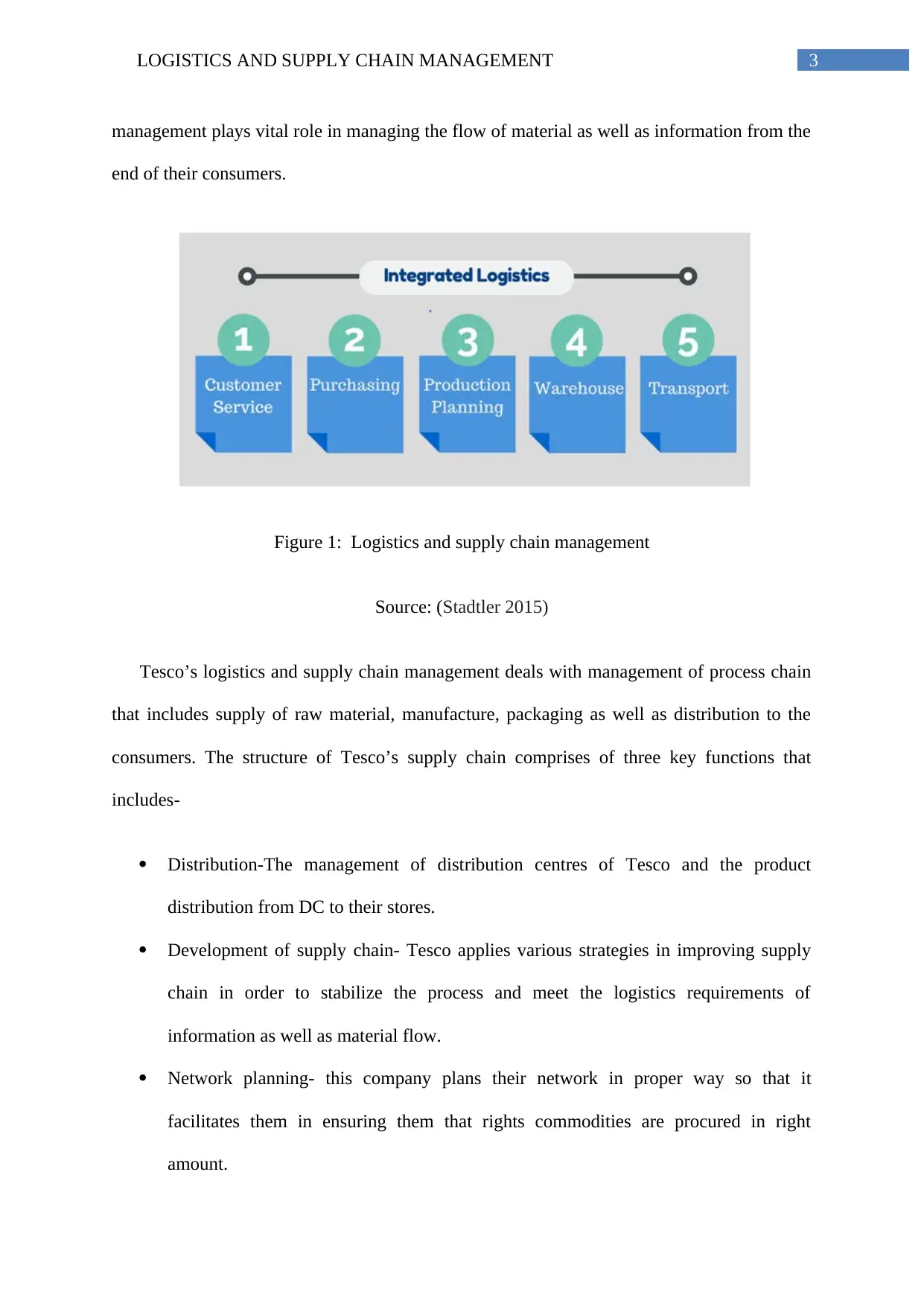
3LOGISTICS AND SUPPLY CHAIN MANAGEMENT
management plays vital role in managing the flow of material as well as information from the
end of their consumers.
Figure 1: Logistics and supply chain management
Source: (Stadtler 2015)
Tesco’s logistics and supply chain management deals with management of process chain
that includes supply of raw material, manufacture, packaging as well as distribution to the
consumers. The structure of Tesco’s supply chain comprises of three key functions that
includes-
Distribution-The management of distribution centres of Tesco and the product
distribution from DC to their stores.
Development of supply chain- Tesco applies various strategies in improving supply
chain in order to stabilize the process and meet the logistics requirements of
information as well as material flow.
Network planning- this company plans their network in proper way so that it
facilitates them in ensuring them that rights commodities are procured in right
amount.
management plays vital role in managing the flow of material as well as information from the
end of their consumers.
Figure 1: Logistics and supply chain management
Source: (Stadtler 2015)
Tesco’s logistics and supply chain management deals with management of process chain
that includes supply of raw material, manufacture, packaging as well as distribution to the
consumers. The structure of Tesco’s supply chain comprises of three key functions that
includes-
Distribution-The management of distribution centres of Tesco and the product
distribution from DC to their stores.
Development of supply chain- Tesco applies various strategies in improving supply
chain in order to stabilize the process and meet the logistics requirements of
information as well as material flow.
Network planning- this company plans their network in proper way so that it
facilitates them in ensuring them that rights commodities are procured in right
amount.
Paraphrase This Document
Need a fresh take? Get an instant paraphrase of this document with our AI Paraphraser
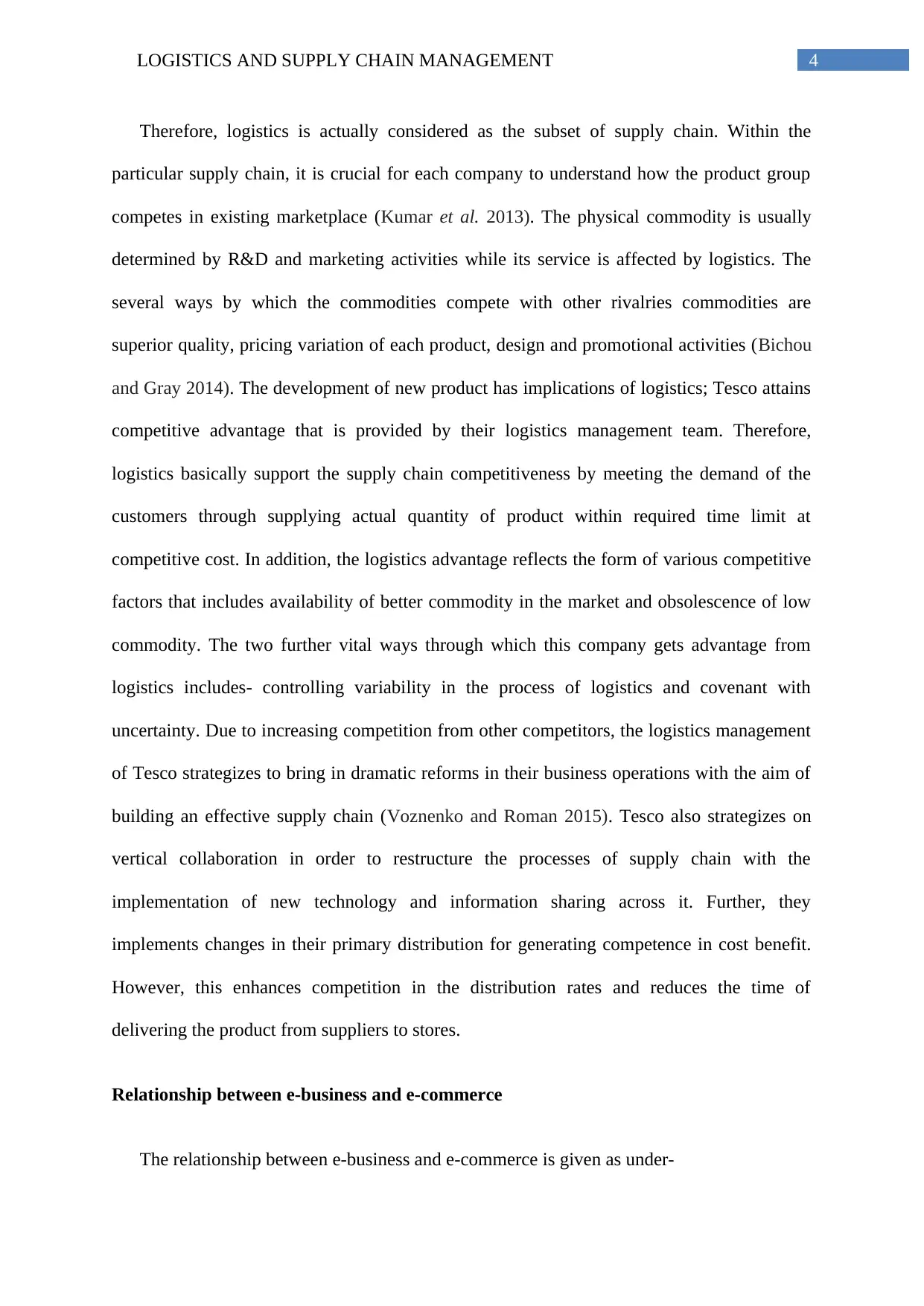
4LOGISTICS AND SUPPLY CHAIN MANAGEMENT
Therefore, logistics is actually considered as the subset of supply chain. Within the
particular supply chain, it is crucial for each company to understand how the product group
competes in existing marketplace (Kumar et al. 2013). The physical commodity is usually
determined by R&D and marketing activities while its service is affected by logistics. The
several ways by which the commodities compete with other rivalries commodities are
superior quality, pricing variation of each product, design and promotional activities (Bichou
and Gray 2014). The development of new product has implications of logistics; Tesco attains
competitive advantage that is provided by their logistics management team. Therefore,
logistics basically support the supply chain competitiveness by meeting the demand of the
customers through supplying actual quantity of product within required time limit at
competitive cost. In addition, the logistics advantage reflects the form of various competitive
factors that includes availability of better commodity in the market and obsolescence of low
commodity. The two further vital ways through which this company gets advantage from
logistics includes- controlling variability in the process of logistics and covenant with
uncertainty. Due to increasing competition from other competitors, the logistics management
of Tesco strategizes to bring in dramatic reforms in their business operations with the aim of
building an effective supply chain (Voznenko and Roman 2015). Tesco also strategizes on
vertical collaboration in order to restructure the processes of supply chain with the
implementation of new technology and information sharing across it. Further, they
implements changes in their primary distribution for generating competence in cost benefit.
However, this enhances competition in the distribution rates and reduces the time of
delivering the product from suppliers to stores.
Relationship between e-business and e-commerce
The relationship between e-business and e-commerce is given as under-
Therefore, logistics is actually considered as the subset of supply chain. Within the
particular supply chain, it is crucial for each company to understand how the product group
competes in existing marketplace (Kumar et al. 2013). The physical commodity is usually
determined by R&D and marketing activities while its service is affected by logistics. The
several ways by which the commodities compete with other rivalries commodities are
superior quality, pricing variation of each product, design and promotional activities (Bichou
and Gray 2014). The development of new product has implications of logistics; Tesco attains
competitive advantage that is provided by their logistics management team. Therefore,
logistics basically support the supply chain competitiveness by meeting the demand of the
customers through supplying actual quantity of product within required time limit at
competitive cost. In addition, the logistics advantage reflects the form of various competitive
factors that includes availability of better commodity in the market and obsolescence of low
commodity. The two further vital ways through which this company gets advantage from
logistics includes- controlling variability in the process of logistics and covenant with
uncertainty. Due to increasing competition from other competitors, the logistics management
of Tesco strategizes to bring in dramatic reforms in their business operations with the aim of
building an effective supply chain (Voznenko and Roman 2015). Tesco also strategizes on
vertical collaboration in order to restructure the processes of supply chain with the
implementation of new technology and information sharing across it. Further, they
implements changes in their primary distribution for generating competence in cost benefit.
However, this enhances competition in the distribution rates and reduces the time of
delivering the product from suppliers to stores.
Relationship between e-business and e-commerce
The relationship between e-business and e-commerce is given as under-
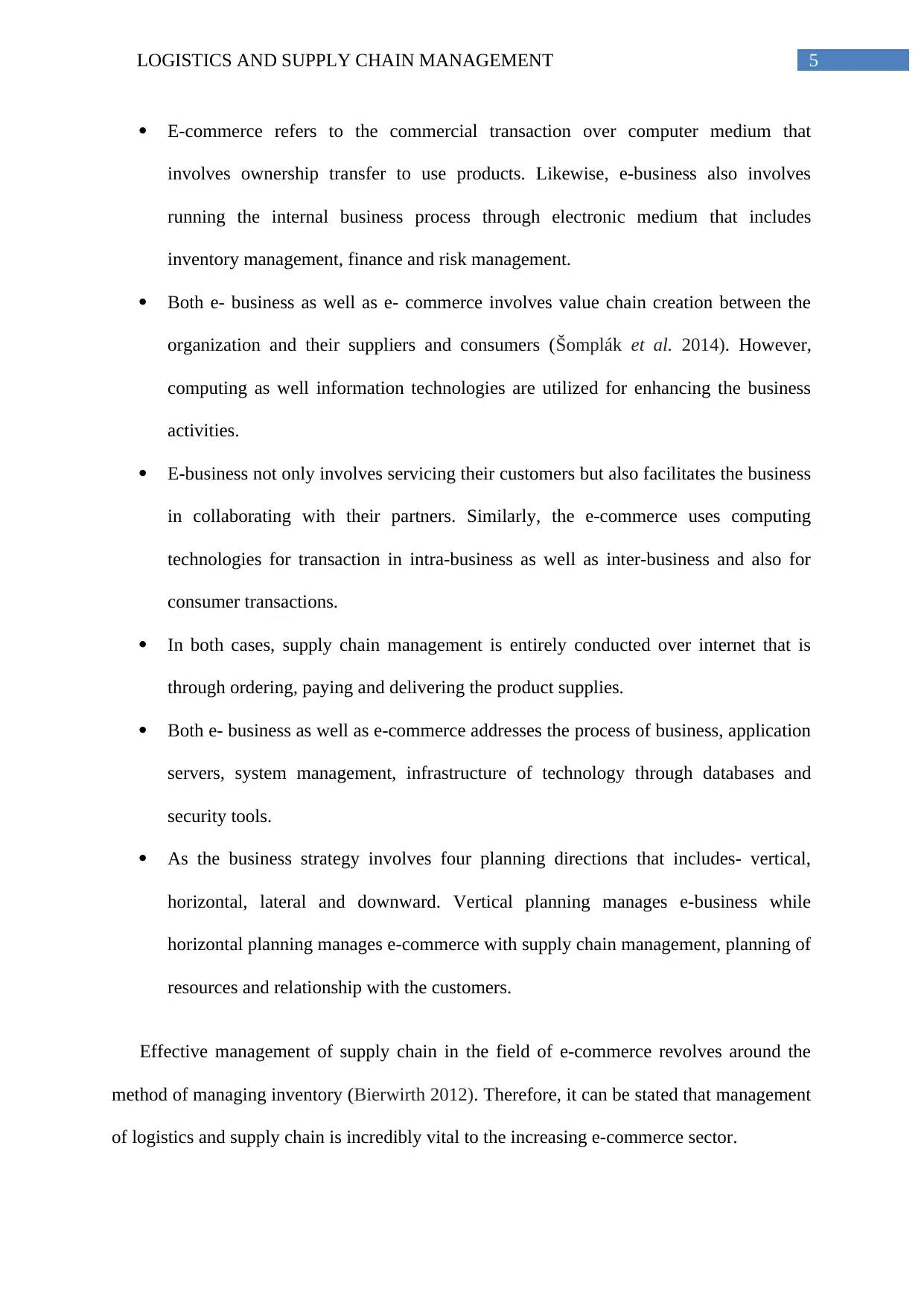
5LOGISTICS AND SUPPLY CHAIN MANAGEMENT
E-commerce refers to the commercial transaction over computer medium that
involves ownership transfer to use products. Likewise, e-business also involves
running the internal business process through electronic medium that includes
inventory management, finance and risk management.
Both e- business as well as e- commerce involves value chain creation between the
organization and their suppliers and consumers (Šomplák et al. 2014). However,
computing as well information technologies are utilized for enhancing the business
activities.
E-business not only involves servicing their customers but also facilitates the business
in collaborating with their partners. Similarly, the e-commerce uses computing
technologies for transaction in intra-business as well as inter-business and also for
consumer transactions.
In both cases, supply chain management is entirely conducted over internet that is
through ordering, paying and delivering the product supplies.
Both e- business as well as e-commerce addresses the process of business, application
servers, system management, infrastructure of technology through databases and
security tools.
As the business strategy involves four planning directions that includes- vertical,
horizontal, lateral and downward. Vertical planning manages e-business while
horizontal planning manages e-commerce with supply chain management, planning of
resources and relationship with the customers.
Effective management of supply chain in the field of e-commerce revolves around the
method of managing inventory (Bierwirth 2012). Therefore, it can be stated that management
of logistics and supply chain is incredibly vital to the increasing e-commerce sector.
E-commerce refers to the commercial transaction over computer medium that
involves ownership transfer to use products. Likewise, e-business also involves
running the internal business process through electronic medium that includes
inventory management, finance and risk management.
Both e- business as well as e- commerce involves value chain creation between the
organization and their suppliers and consumers (Šomplák et al. 2014). However,
computing as well information technologies are utilized for enhancing the business
activities.
E-business not only involves servicing their customers but also facilitates the business
in collaborating with their partners. Similarly, the e-commerce uses computing
technologies for transaction in intra-business as well as inter-business and also for
consumer transactions.
In both cases, supply chain management is entirely conducted over internet that is
through ordering, paying and delivering the product supplies.
Both e- business as well as e-commerce addresses the process of business, application
servers, system management, infrastructure of technology through databases and
security tools.
As the business strategy involves four planning directions that includes- vertical,
horizontal, lateral and downward. Vertical planning manages e-business while
horizontal planning manages e-commerce with supply chain management, planning of
resources and relationship with the customers.
Effective management of supply chain in the field of e-commerce revolves around the
method of managing inventory (Bierwirth 2012). Therefore, it can be stated that management
of logistics and supply chain is incredibly vital to the increasing e-commerce sector.
⊘ This is a preview!⊘
Do you want full access?
Subscribe today to unlock all pages.

Trusted by 1+ million students worldwide
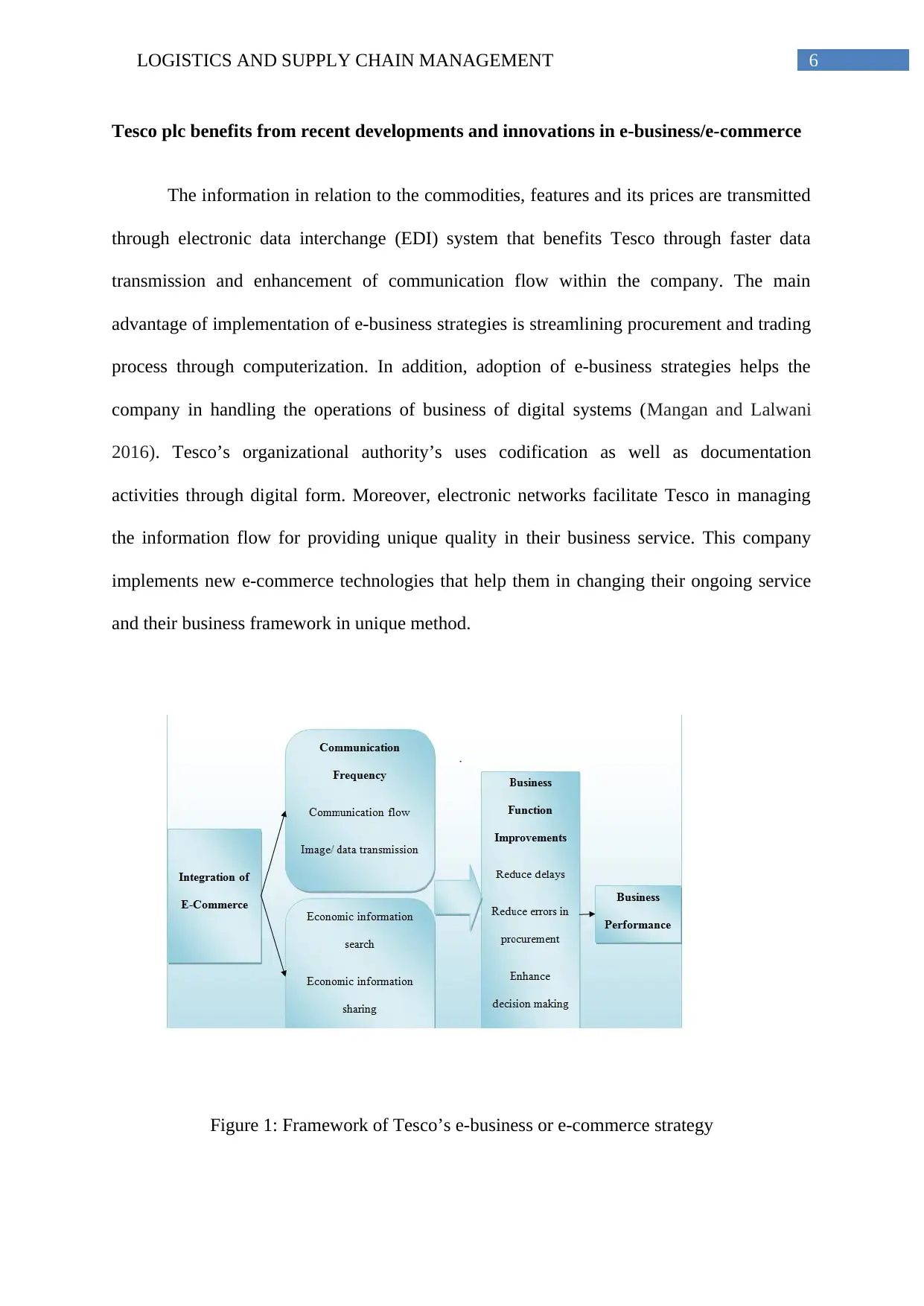
6LOGISTICS AND SUPPLY CHAIN MANAGEMENT
Tesco plc benefits from recent developments and innovations in e-business/e-commerce
The information in relation to the commodities, features and its prices are transmitted
through electronic data interchange (EDI) system that benefits Tesco through faster data
transmission and enhancement of communication flow within the company. The main
advantage of implementation of e-business strategies is streamlining procurement and trading
process through computerization. In addition, adoption of e-business strategies helps the
company in handling the operations of business of digital systems (Mangan and Lalwani
2016). Tesco’s organizational authority’s uses codification as well as documentation
activities through digital form. Moreover, electronic networks facilitate Tesco in managing
the information flow for providing unique quality in their business service. This company
implements new e-commerce technologies that help them in changing their ongoing service
and their business framework in unique method.
Figure 1: Framework of Tesco’s e-business or e-commerce strategy
Tesco plc benefits from recent developments and innovations in e-business/e-commerce
The information in relation to the commodities, features and its prices are transmitted
through electronic data interchange (EDI) system that benefits Tesco through faster data
transmission and enhancement of communication flow within the company. The main
advantage of implementation of e-business strategies is streamlining procurement and trading
process through computerization. In addition, adoption of e-business strategies helps the
company in handling the operations of business of digital systems (Mangan and Lalwani
2016). Tesco’s organizational authority’s uses codification as well as documentation
activities through digital form. Moreover, electronic networks facilitate Tesco in managing
the information flow for providing unique quality in their business service. This company
implements new e-commerce technologies that help them in changing their ongoing service
and their business framework in unique method.
Figure 1: Framework of Tesco’s e-business or e-commerce strategy
Paraphrase This Document
Need a fresh take? Get an instant paraphrase of this document with our AI Paraphraser
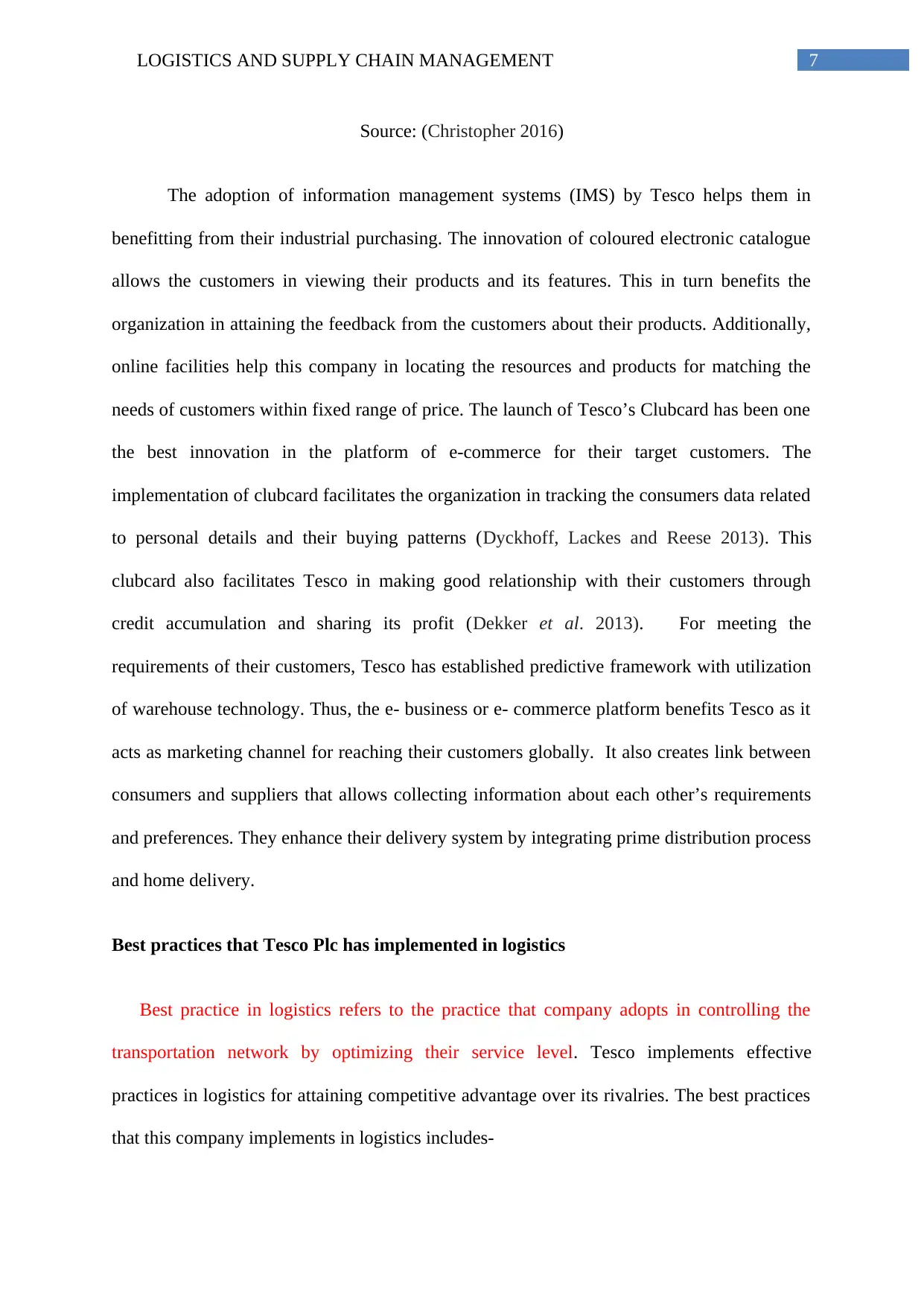
7LOGISTICS AND SUPPLY CHAIN MANAGEMENT
Source: (Christopher 2016)
The adoption of information management systems (IMS) by Tesco helps them in
benefitting from their industrial purchasing. The innovation of coloured electronic catalogue
allows the customers in viewing their products and its features. This in turn benefits the
organization in attaining the feedback from the customers about their products. Additionally,
online facilities help this company in locating the resources and products for matching the
needs of customers within fixed range of price. The launch of Tesco’s Clubcard has been one
the best innovation in the platform of e-commerce for their target customers. The
implementation of clubcard facilitates the organization in tracking the consumers data related
to personal details and their buying patterns (Dyckhoff, Lackes and Reese 2013). This
clubcard also facilitates Tesco in making good relationship with their customers through
credit accumulation and sharing its profit (Dekker et al. 2013). For meeting the
requirements of their customers, Tesco has established predictive framework with utilization
of warehouse technology. Thus, the e- business or e- commerce platform benefits Tesco as it
acts as marketing channel for reaching their customers globally. It also creates link between
consumers and suppliers that allows collecting information about each other’s requirements
and preferences. They enhance their delivery system by integrating prime distribution process
and home delivery.
Best practices that Tesco Plc has implemented in logistics
Best practice in logistics refers to the practice that company adopts in controlling the
transportation network by optimizing their service level. Tesco implements effective
practices in logistics for attaining competitive advantage over its rivalries. The best practices
that this company implements in logistics includes-
Source: (Christopher 2016)
The adoption of information management systems (IMS) by Tesco helps them in
benefitting from their industrial purchasing. The innovation of coloured electronic catalogue
allows the customers in viewing their products and its features. This in turn benefits the
organization in attaining the feedback from the customers about their products. Additionally,
online facilities help this company in locating the resources and products for matching the
needs of customers within fixed range of price. The launch of Tesco’s Clubcard has been one
the best innovation in the platform of e-commerce for their target customers. The
implementation of clubcard facilitates the organization in tracking the consumers data related
to personal details and their buying patterns (Dyckhoff, Lackes and Reese 2013). This
clubcard also facilitates Tesco in making good relationship with their customers through
credit accumulation and sharing its profit (Dekker et al. 2013). For meeting the
requirements of their customers, Tesco has established predictive framework with utilization
of warehouse technology. Thus, the e- business or e- commerce platform benefits Tesco as it
acts as marketing channel for reaching their customers globally. It also creates link between
consumers and suppliers that allows collecting information about each other’s requirements
and preferences. They enhance their delivery system by integrating prime distribution process
and home delivery.
Best practices that Tesco Plc has implemented in logistics
Best practice in logistics refers to the practice that company adopts in controlling the
transportation network by optimizing their service level. Tesco implements effective
practices in logistics for attaining competitive advantage over its rivalries. The best practices
that this company implements in logistics includes-
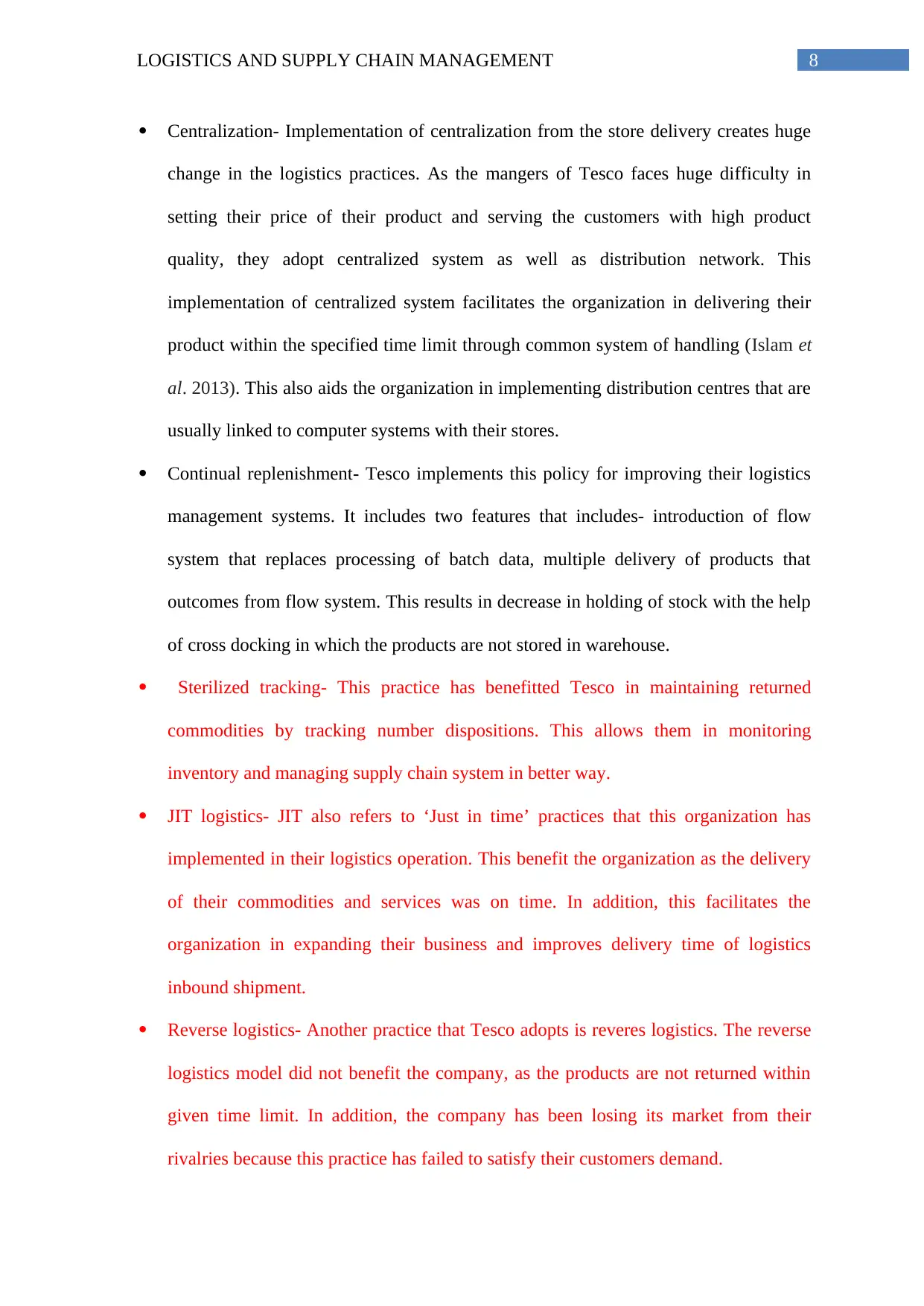
8LOGISTICS AND SUPPLY CHAIN MANAGEMENT
Centralization- Implementation of centralization from the store delivery creates huge
change in the logistics practices. As the mangers of Tesco faces huge difficulty in
setting their price of their product and serving the customers with high product
quality, they adopt centralized system as well as distribution network. This
implementation of centralized system facilitates the organization in delivering their
product within the specified time limit through common system of handling (Islam et
al. 2013). This also aids the organization in implementing distribution centres that are
usually linked to computer systems with their stores.
Continual replenishment- Tesco implements this policy for improving their logistics
management systems. It includes two features that includes- introduction of flow
system that replaces processing of batch data, multiple delivery of products that
outcomes from flow system. This results in decrease in holding of stock with the help
of cross docking in which the products are not stored in warehouse.
Sterilized tracking- This practice has benefitted Tesco in maintaining returned
commodities by tracking number dispositions. This allows them in monitoring
inventory and managing supply chain system in better way.
JIT logistics- JIT also refers to ‘Just in time’ practices that this organization has
implemented in their logistics operation. This benefit the organization as the delivery
of their commodities and services was on time. In addition, this facilitates the
organization in expanding their business and improves delivery time of logistics
inbound shipment.
Reverse logistics- Another practice that Tesco adopts is reveres logistics. The reverse
logistics model did not benefit the company, as the products are not returned within
given time limit. In addition, the company has been losing its market from their
rivalries because this practice has failed to satisfy their customers demand.
Centralization- Implementation of centralization from the store delivery creates huge
change in the logistics practices. As the mangers of Tesco faces huge difficulty in
setting their price of their product and serving the customers with high product
quality, they adopt centralized system as well as distribution network. This
implementation of centralized system facilitates the organization in delivering their
product within the specified time limit through common system of handling (Islam et
al. 2013). This also aids the organization in implementing distribution centres that are
usually linked to computer systems with their stores.
Continual replenishment- Tesco implements this policy for improving their logistics
management systems. It includes two features that includes- introduction of flow
system that replaces processing of batch data, multiple delivery of products that
outcomes from flow system. This results in decrease in holding of stock with the help
of cross docking in which the products are not stored in warehouse.
Sterilized tracking- This practice has benefitted Tesco in maintaining returned
commodities by tracking number dispositions. This allows them in monitoring
inventory and managing supply chain system in better way.
JIT logistics- JIT also refers to ‘Just in time’ practices that this organization has
implemented in their logistics operation. This benefit the organization as the delivery
of their commodities and services was on time. In addition, this facilitates the
organization in expanding their business and improves delivery time of logistics
inbound shipment.
Reverse logistics- Another practice that Tesco adopts is reveres logistics. The reverse
logistics model did not benefit the company, as the products are not returned within
given time limit. In addition, the company has been losing its market from their
rivalries because this practice has failed to satisfy their customers demand.
⊘ This is a preview!⊘
Do you want full access?
Subscribe today to unlock all pages.

Trusted by 1+ million students worldwide
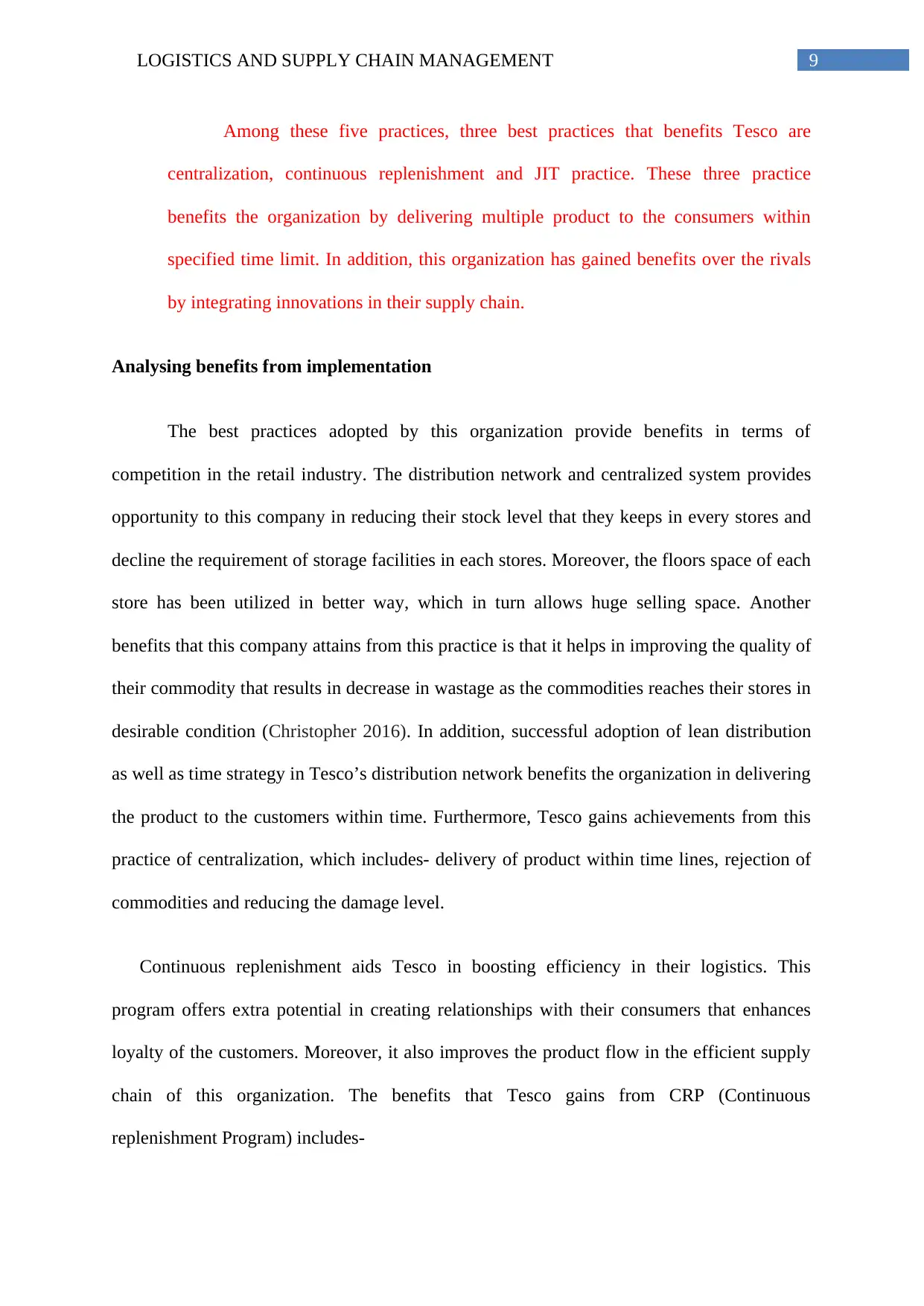
9LOGISTICS AND SUPPLY CHAIN MANAGEMENT
Among these five practices, three best practices that benefits Tesco are
centralization, continuous replenishment and JIT practice. These three practice
benefits the organization by delivering multiple product to the consumers within
specified time limit. In addition, this organization has gained benefits over the rivals
by integrating innovations in their supply chain.
Analysing benefits from implementation
The best practices adopted by this organization provide benefits in terms of
competition in the retail industry. The distribution network and centralized system provides
opportunity to this company in reducing their stock level that they keeps in every stores and
decline the requirement of storage facilities in each stores. Moreover, the floors space of each
store has been utilized in better way, which in turn allows huge selling space. Another
benefits that this company attains from this practice is that it helps in improving the quality of
their commodity that results in decrease in wastage as the commodities reaches their stores in
desirable condition (Christopher 2016). In addition, successful adoption of lean distribution
as well as time strategy in Tesco’s distribution network benefits the organization in delivering
the product to the customers within time. Furthermore, Tesco gains achievements from this
practice of centralization, which includes- delivery of product within time lines, rejection of
commodities and reducing the damage level.
Continuous replenishment aids Tesco in boosting efficiency in their logistics. This
program offers extra potential in creating relationships with their consumers that enhances
loyalty of the customers. Moreover, it also improves the product flow in the efficient supply
chain of this organization. The benefits that Tesco gains from CRP (Continuous
replenishment Program) includes-
Among these five practices, three best practices that benefits Tesco are
centralization, continuous replenishment and JIT practice. These three practice
benefits the organization by delivering multiple product to the consumers within
specified time limit. In addition, this organization has gained benefits over the rivals
by integrating innovations in their supply chain.
Analysing benefits from implementation
The best practices adopted by this organization provide benefits in terms of
competition in the retail industry. The distribution network and centralized system provides
opportunity to this company in reducing their stock level that they keeps in every stores and
decline the requirement of storage facilities in each stores. Moreover, the floors space of each
store has been utilized in better way, which in turn allows huge selling space. Another
benefits that this company attains from this practice is that it helps in improving the quality of
their commodity that results in decrease in wastage as the commodities reaches their stores in
desirable condition (Christopher 2016). In addition, successful adoption of lean distribution
as well as time strategy in Tesco’s distribution network benefits the organization in delivering
the product to the customers within time. Furthermore, Tesco gains achievements from this
practice of centralization, which includes- delivery of product within time lines, rejection of
commodities and reducing the damage level.
Continuous replenishment aids Tesco in boosting efficiency in their logistics. This
program offers extra potential in creating relationships with their consumers that enhances
loyalty of the customers. Moreover, it also improves the product flow in the efficient supply
chain of this organization. The benefits that Tesco gains from CRP (Continuous
replenishment Program) includes-
Paraphrase This Document
Need a fresh take? Get an instant paraphrase of this document with our AI Paraphraser

10LOGISTICS AND SUPPLY CHAIN MANAGEMENT
Rise in inventory turns
Decreasing level of inventory
Reduce stock out
Enhance warehouse efficiency
Improving the level of customer service
Increase value perception of the trading partners
Conclusion
From the above report, it can be concluded that changes in operation of logistics and
supply chain helps them in attaining competitive advantage over their competitors. Up
gradation of technology and innovation of new practices of logistics also facilitates in
maintaining consistent delivery in their service. In addition, incorporation of technologies of
e-business benefits the organization for attaining higher profitability and achieving their goal.
Effective implementation of these technologies helps this company in producing and
delivering the commodity within less time. Adoption of e-business strategies with reform
logistics as well as procurement operations facilitates in providing their customers good
quality retail services. The introduction of Clubcard helps the organization in retaining
customers loyalty and attract more customers, which in turn maximizes the business profit.
Therefore, adoption of e-business strategy in business activities creates difficulties for the
business authorities that include security vulnerabilities as well as poor knowledge about the
customers. However, it is necessary to restructure the already existing e-commerce or e-
business framework for the company in order to provide potential benefits as well as
opportunities to their target customers by fulfilling their requirements on first priority.
Rise in inventory turns
Decreasing level of inventory
Reduce stock out
Enhance warehouse efficiency
Improving the level of customer service
Increase value perception of the trading partners
Conclusion
From the above report, it can be concluded that changes in operation of logistics and
supply chain helps them in attaining competitive advantage over their competitors. Up
gradation of technology and innovation of new practices of logistics also facilitates in
maintaining consistent delivery in their service. In addition, incorporation of technologies of
e-business benefits the organization for attaining higher profitability and achieving their goal.
Effective implementation of these technologies helps this company in producing and
delivering the commodity within less time. Adoption of e-business strategies with reform
logistics as well as procurement operations facilitates in providing their customers good
quality retail services. The introduction of Clubcard helps the organization in retaining
customers loyalty and attract more customers, which in turn maximizes the business profit.
Therefore, adoption of e-business strategy in business activities creates difficulties for the
business authorities that include security vulnerabilities as well as poor knowledge about the
customers. However, it is necessary to restructure the already existing e-commerce or e-
business framework for the company in order to provide potential benefits as well as
opportunities to their target customers by fulfilling their requirements on first priority.

11LOGISTICS AND SUPPLY CHAIN MANAGEMENT
⊘ This is a preview!⊘
Do you want full access?
Subscribe today to unlock all pages.

Trusted by 1+ million students worldwide
1 out of 13
Related Documents
Your All-in-One AI-Powered Toolkit for Academic Success.
+13062052269
info@desklib.com
Available 24*7 on WhatsApp / Email
![[object Object]](/_next/static/media/star-bottom.7253800d.svg)
Unlock your academic potential
Copyright © 2020–2025 A2Z Services. All Rights Reserved. Developed and managed by ZUCOL.





